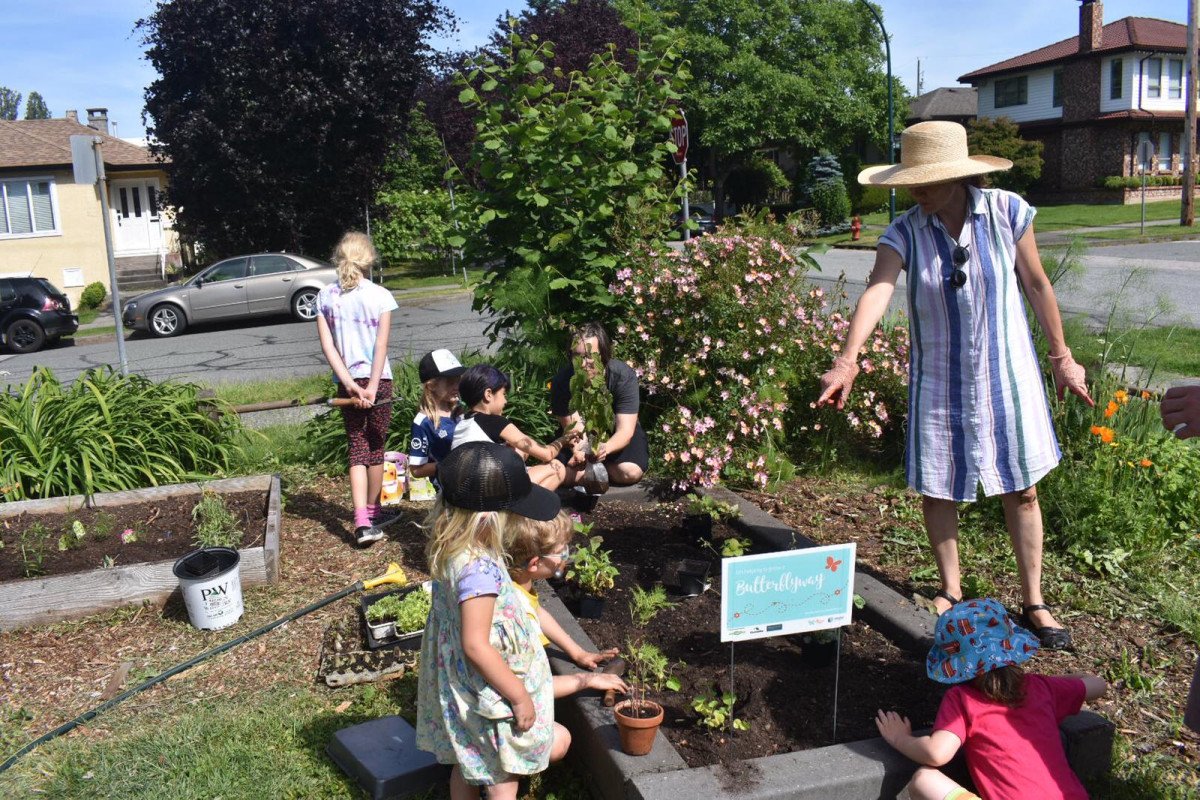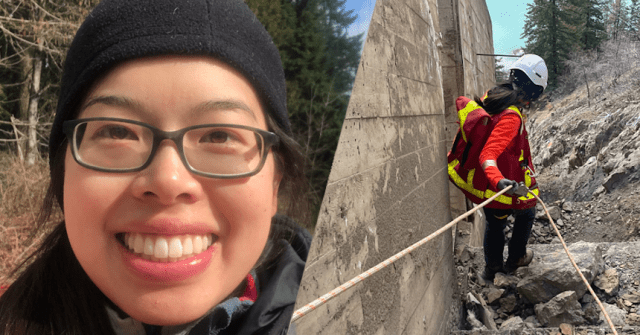' Walk with me, Suzy LeeThrough the park and by the tree
We will rest upon the ground
And look at all the bugs we found'
– From 'We're Going to Be Friends' by White Stripes
Once kids get around the ick and fear factors around bugs, bees, and worms, a whole world of wonder opens up to them.
They learn that most bees have no interest in stinging you, that some don't even have stingers, and that pollinators include butterflies, wasps, ants, and hummingbirds.
They discover the importance of the role gardens play in helping revive pollinator habitat, and which plants pollinators love. And they learn that 90% of plants in our ecosystems, and 70% of agricultural crop plants, rely on pollinators to survive. They provide food crops responsible for one out of every three bites of food we eat.
But first, they need to get used to being around bees and bugs.
"Some kids are so unfamiliar with insects that anything that flies around their head scares them," says Jana Ronne, a fierce gardens advocate who teaches math and science at Gladstone Secondary in East Vancouver. "When we go out to the garden and something starts flying, they run. It's that extreme of a response."
Ronne says that wandering forests a lot as a child, in part to escape a tough situation at home, helped her form very strong bonds with nature. She now makes a point of using gardens to bring more nature to city dwellers. She says that because some parents either can't afford to send their kids on field trips, or are reluctant to allow them to go, a garden at a school can be a powerful alternative.
"The kids love being part of any planting, and they love observing the critters," she says. "When my children were at Garibaldi Annex we had one day a week at lunch hour where a parent came and opened up a box of tools. We left it unstructured. Some students helped with weeding, but they usually ended up just digging for worms. We never had trouble attracting the kids into the garden. They just loved using the shovels."
Ronne is busy at least three gardens in East Vancouver, including the one at Gladstone Secondary where she teaches, the one that covers the corner lot of her East Vancouver home, and the wildly popular Garibaldi Annex garden. It lives on despite the closure of Garibaldi Annex elementary school in 2018, and also serves as an occasional school garden space for the Life Skills program at Britannia Secondary.
She would like to help kids and teens form a connection to nature.
"I really struggle with the legacy of our human race – the continuous encroachment on all non-human life forms," she wrote in a blog post about her pollinator garden project at Gladstone Secondary.
"I am trying to help my students see the beauty of what remains by taking them hiking, giving them the opportunity to learn how to grow food, and teaching them how to recognize some important local and not-so-local plants."
Ronne says one of the big wins with the garden at Gladstone is an environmental studies class that offers at-risk kids at the school an alternative for their Grade 11 science credit.
"These are my wonder kids, and they love being in the garden and doing things," she says. "They're not necessarily involved with the butterfly garden, but I have them grow food, track insects, take pictures of them and talk about them and their importance."
She likes to use a set of native plant cards that include a photo of each plant as a tool for helping students identify plants in the garden and beyond. She has used the cards for treasure hunts that bring students closer to the garden, where they discover everything from hummingbirds, to robin and crows nests. She uses visits to the garden as "body breaks" for students who feel cooped up in their classes.
A beekeeper who has hives outside her home, Ronne says that so far, she has seen no students stung while visiting any of the gardens she tends to. That's not surprising, given that bees have little interest in stinging us.
"I let the kids know that the likelihood of actually getting stung is so small," she says. "And if I see an amazing bumblebee stop in the garden long enough, I show that that I can actually pet them and they don't get angry at me for it. I show the kids that we can interact with them – that they are not so ominous and scary."
Pollinators threatened by pesticides and other factors
Habitat loss, disease, parasites, and environmental contaminants have all contributed to the decline of many species of pollinators. A number of organizations in Canada have sprung up to help add pollinator habitat across the nation, and Health Canada's Pest Management Regulatory Agency has worked to develop best practices for pollinator protection for the agriculture industry.
Border Free Bees offers a variety of tips around pollination gardens, ranging from a bumblebee guide, to a mason bee colouring page, bee hotel building advice and a 36-card set of bee observer cards. Bee City Canada recognizes communities and organizations, including schools, that are taking steps to help pollinators, and the Government of B.C. has a list of bee forage plants.
Exploration of pollinator gardens maps nicely to BC's school curriculum, from big ideas around living things, daily and seasonal changes in kindergarten and early grades, to environmental science courses in Grades 11 and 12. Across B.C., teachers and schools are getting involved in pollinator gardens. A Grade 6/7 class at Pacific Way Elementary in Kamloops used a $500 grant in 2022 to help launch a garden, and nine B.C. schools are on the Bee Schools list recognized by Bee City Canada. And the Society Promoting Environmental Conservation (SPEC) offers great lesson activities to help bring kids outdoors.
Gladstone's Ronne offered a couple tips for teachers who might want to start a pollinator and/or food garden at their school. She says to look for funding help from various community organizations – the Garibaldi Annex garden landed plant donations from the Canadian Wildlife Federation and the Environmental Youth Alliance – and to be patient.
"Like gardening in general, these are experiments, and sometimes experiments don't go well," she says. "Sometimes it can take a few years to really get a garden off the ground."
And if you don't have a garden, look for opportunities locally, at butterflyways and pollinator gardens, and in forests and fields, to take students out of their comfort zone and into the greater world. BC Hydro works with local organizations through the Community ReGreening program to deliver pollinator gardens, such as the Bridgeport Public Art Pollinator Pasture along a BC Hydro power line right-of-way in Richmond.
Other pollinator gardens in B.C. include:
Bees and beyond: Hands-on activities for exploring nature
We have activities that provide interactive, hands-on experiences for students, including several that call for adventures outside the classroom.
Bee smart (Kindergarten to Grade 3)
By simulating pollination in the classroom, learning about bees, and then creating bees using egg cartons and other supplies, students learn how bees pollinate.
Biodiversity and white sturgeon in B.C. (Grade 3)
Students explore, through games, drawing and crafting, how we can protect our ecosystems.
Outdoor energy transformation hunt (Grade 4)
Students search for energy transformations in nature and around school grounds, with an option of going on a field trip to a local park.
What's that sound? (Grade 1)
Students head outside to listen and identify sounds, both natural and artificial, then draw them on a sound map.
Outdoor weather walk (Kindergarten)
Teachers take students outside for a 20-minute walk around the neighbourhood to observe and discuss seasonal changes. Upon returning to the classroom, students are asked to draw pictures of what reminds them of the season.
Catch the rain (Grade 2)
Using empty pop bottles to build a rain gauge, students then measure and track how much rain falls each day.
Get energized (Kindergarten, Grade 1)
Outside or in the gym, students learn how exercise affects their bodies and how they use energy. Song and an art activity helps students further explore how they use energy.
Nature connections (Grade 7)
Show a video about Indigenous Nations connection to their land and place and then have students think about a special place in nature.






